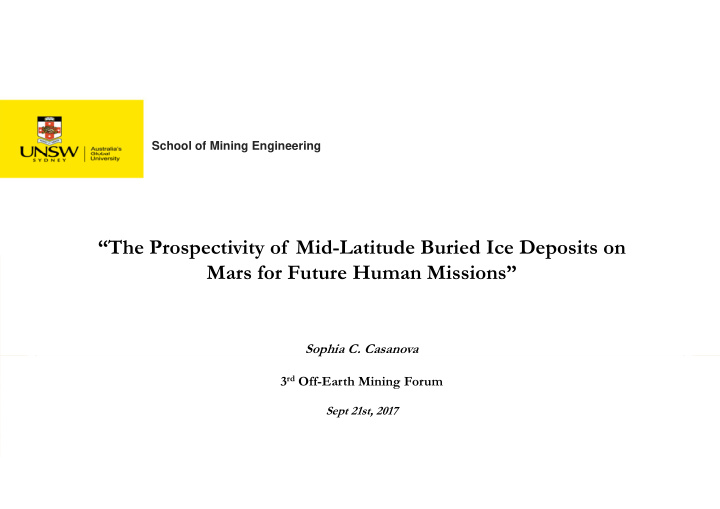



School of Mining Engineering “The Prospectivity of Mid-Latitude Buried Ice Deposits on Mars for Future Human Missions” Sophia C. Casanova 3 rd Off-Earth Mining Forum Sept 21st, 2017
\
Water Resources on Mars Background colors represent topography from MOLA. SR-SAG2 May 1, 2014
Mid-latitude Buried Ice Deposits Landforms suggesting the presence of ice in the recent past LDA CCF CCF LDA Lobate Debris Aprons (LDA) Concentric Crater Fill (CCF) GLF GLF GLF LVF LVF LDA GLF LDA Martian Dichotomy Boundary Lineated Valley Fill (LVF) Glacier Like Feature Under appropriate physical and geological conditions, these features could (GLF) mark the presence of significant ice reservoirs outside the polar regions
Layered Ejecta Craters Presence of ejecta blankets surrounding craters suggest ice was present at the surface or within the shallow subsurface at the time of impact Example of a Layered Ejecta Crater – Protonilus Mensae CCF N N Double Layer Ejecta Blanket Single Layer Ejecta Blanket Crater Rim Layered Ejecta Craters
Mid-Latitude Buried Ice Deposits Glacier Like Feature – Flow Lines (HiRISE - 25cm/pixel) N Geomorphic Map of study region with the Protonilus Mensae Ice Free Terrain Ice Free Terrain - Mesa Terrestrial Analogue - Debris Covered Glacier – Lobate Debris Aprons – Upper Unit Talkeetna Mountains – Lobate Debris Aprons – Lower Unit Alaska (USGS) Glacier Like Feature
Exploration Processes and Techniques Exploration Exploration End of life / End of life / Feasibility Feasibility Identify New Mine Closure Mine Closure Studies Studies Exploration Targets Mine Mine Mine Planning Mine Planning Development Development and and and Operation and Operation Construction Construction The Typical Mining Life Cycle Mars Reconnaissance Orbiter MSL Curiosity Rover (NASA/JPL) (NASA/JPL)
Exploration Target and Resource Estimation Process • Define resource requirements, deposit type and select exploration zone • Develop a geological model of deposits (incorporating geomorphic, topographical structural, mineralogical & geophysical data) - Interpret controls on development and preservation • Define resource regions of interest (RROI) – Exploration Targets / prospects for In-situ study by a robotic rover. Debris Covered Glacier Interior Schematic Parameters to consider: • Water content • Englaical rock properties Additional evaluation • Ice thickness requirements will depend on selected • Size and shape of deposit mining method • Areal extent • Continuity and spatial variation Debris Covered Glacier Arial View (CTX)
Engineering Constraints & Mine Planning: Engineering Constraints: • Presence of appropriate landing sites • Distance from landing, MAV & crew habitation site to RROI • Slope and roughness of terrain (trafficability) • Depth to ice (thickness of supraglacial debris) • Supraglacial & englacial debris properties Example of a proposed Human Mission Exploration Zone - Deuteronilus Mensae (Plaut et. al. 2015) Other Considerations: • Scientific regions of interest • Planetary protection • Market and economic factors
Summary • Large water ice deposits are likely preserved under a layer of debris in the mid-latitude regions of Mars – represent a potential site for future human operations • Requirement to develop detailed geological models to evaluate exploration targets / prospects utilising orbital datasets • Resource estimation will require in-situ evaluation N The Protonilus Mensae • Specific data requirements for resource estimates and feasibility studies will be dependant upon mining method.
Recommend
More recommend